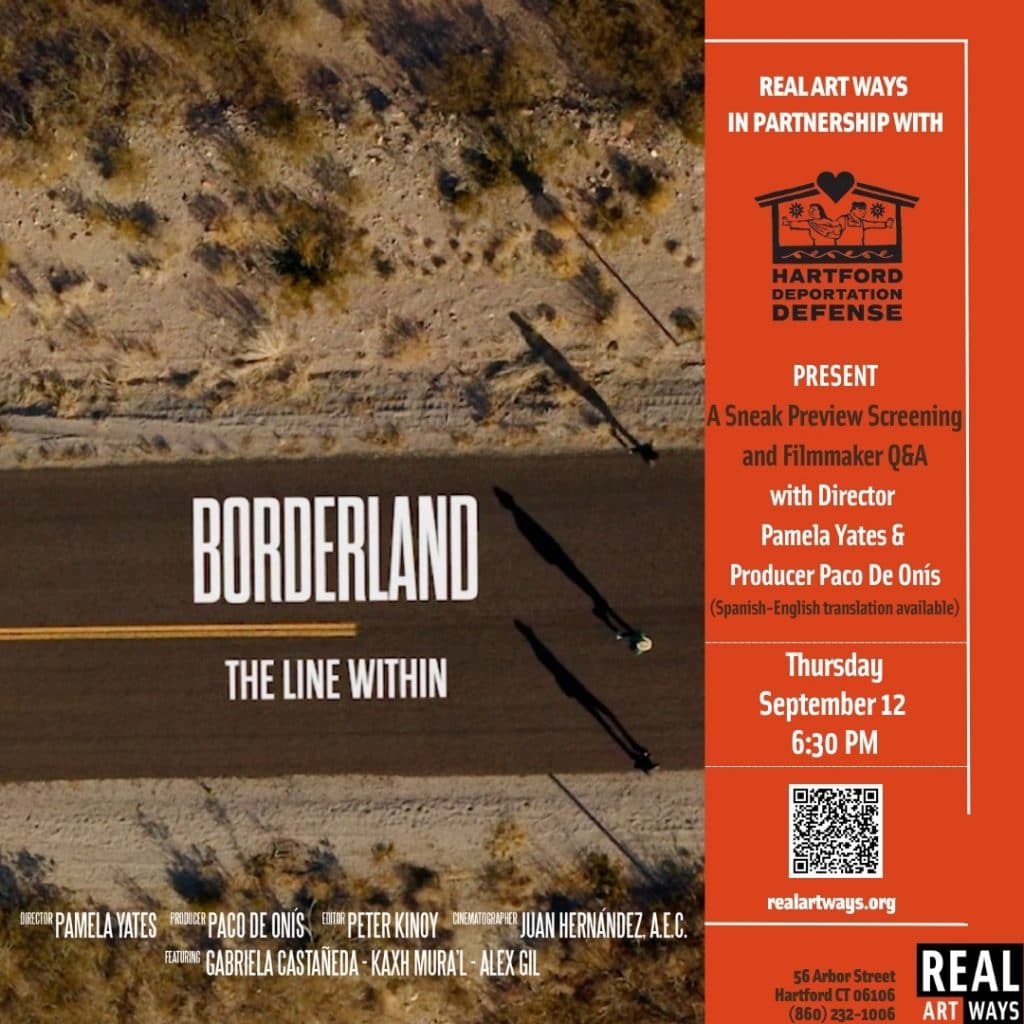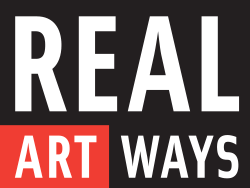Event
EVENTS
Borderland I The Line Within
We are hosting a one-night event on Thursday, September 12, at 6:30 pm – a documentary screening and Q&A with filmmakers Pamela Yates (Director) and Paco de Onís (Producer) – in our cinema.
Getting advance tickets is highly recommended. 
Logline
There is a war on immigrants. A massive surveillance, militarized, and carceral apparatus has been built to capture, imprison, and deport millions. But in the shadow of this border industrial complex, immigrants are building a rights movement envisioning a future rooted in human connection and the sanctity of life.Synopsis
The United States border is not just a geographic location. The border is everywhere. It lies within every undocumented immigrant family with the threat that, at any moment, they can be captured, incarcerated, deported; their lives destroyed. BORDERLAND | The Line Within not only exposes the profitable business of immigration and its human cost, but weaves together the stories of immigrant heroines and heroes resisting and showing a way forward, intent on building a movement in the shadow of the border industrial complex, recognizing the human rights of all.Director’s Statement (Pamela Yates)
BORDERLAND l The Line Within is a critique of my country’s inhumane treatment of people arriving in the U.S. It’s about the use of immigration as a gateway to fascist ideology and political power. I’ve been making films internationally for the past 20 years but feel it is important to have a critique of my own country now. I searched among Americans finding creative ways to resist the cruelty of our immigration policies, but instead I found a dynamic movement growing among undocumented immigrants to organize, educate themselves, demand their rights and become a force. Weaving the story together by scraping the web and invoking the Freedom of Information Act, I chose a trio of experimental digital humanists artfully exposing the business of immigration, a multibillion-dollar system to stop people from crossing the border, incarcerate them and deport them. Making this film would take five years. Pamela Yates filming with cinematographer Juan Hernández, AEC, in the Sonoran Desert Never has my work as a human rights defender and documentary filmmaker come together so closely nor been so demanding. Never had I had to depend so strongly on the collaboration of the protagonists in telling their stories. For example, when Kaxh Mura’l an environmental defender of the Maya-Ixil ancestral lands was threatened with death for his activism, he fled his homeland Guatemala and began the dangerous journey to seek asylum in the U.S. Since he was in my previous film, 500 Years, he contacted me upon leaving so of course I was going to do what I could to help him. He’s a beautiful writer and an important leader. Together we would tell his story. When Kaxh arrived in Ciudad Juárez, Mexico, I got him a pro bono lawyer just across the border in El Paso who could travel back and forth and represent him. I acted as a kind of paralegal to the lawyer Carlos Spector, doing research, gathering documentation, creating briefs to argue the case in court, and writing an affidavit for Kaxh as well as his traveling companion Francisco. Together we formed a circle of solidarity made up of Carlos, Giovanni Batz, a PhD in social anthropology, church supporters, and humanitarian aid people working in the El Paso/Juárez corridor. We’d meet weekly to move Kaxh and Francisco’s cases forward and provide for their needs. I knew I had to be completely transparent about my involvement in how the filmmaker helped shape the story. I did it through sparse narration, and Kaxh’s harrowing WhatsApp voice messaging back and forth with me. We laid bare the process of making the film, which is another interesting facet of the film itself. BORDERLAND would be connected to The Resistance Saga, the trilogy of films about Guatemala that I had made over the past 35 years, but it would take place in the U.S. As Mayan immigration increased – there are now thought to be more than 1 million Mayan people in the diaspora here – I thought of BORDERLAND as a kind of continuation of the story and of our work. I was so fortunate to meet Gabriela Castañeda of The Border Network for Human Rights and for her to collaborate with me over the years it took to make this film. Gaby, talented organizer that she has become, showed me what special perseverance it takes to build leadership when people are so afraid. She brought us into places where immigrants felt free to talk to her and to each other about this fear and how it affected their children. Though in danger of being deported for her activism, Gaby’s sharp intelligence always put others first and she knew how to bring out the greatest leadership potential in each person she encountered. Together with Juan Hernández, the cinematographer who lives in northern Mexico and who is best known for his dramatic feature films, we devised a look that made the most of the anamorphic widescreen format 2.39:1 (for a more epic feel) as we wove complicated stories together using only prime lenses. I wanted to capture the majesty and terror of the landscapes, the border wall scar, the excitement of creating power in numbers as immigrants formed networks across the country. I thought about how to visualize an almost subversive environment for the xpMethod digital humanists, a liminal space to expose the cruelty of what our tax dollars are supporting, often without our knowledge. BORDERLAND was filmed to be seen on the big screen, it’s my commitment to the future of cinema. The recorded location sound had to be perfect, always difficult in documentary filmmaking where you have no control over the surroundings. I began my career as a sound recordist, so you can only imagine how demanding I am of sound recordists on my own films. David Fournier Castillo is the prodigy sound recordist from Mexico City who made all the difference in his close attention to recording the soundscape. From the Arizona desert to studio shoots in New York City, he came through to deliver magnificent sound. I had always wanted Sara Curruchich to compose and perform the musical soundtrack on BORDERLAND. I knew she would bring Mayan sensibilities, instrumentation and vocalization to evoke the tragedy of being forced to flee, and the nostalgia for family, land, language, and culture left behind. Our long-time composer Roger C. Miller joined Sara and together they created the extraordinary film music track. The meaning of the title BORDERLAND | The Line Within is at the heart of the film. The border is not geographical line, but rather a vast border industrial complex entrenched in every corner of the U.S. It is inside each and every undocumented person because wherever they may be, the fear of being discovered and deported is looming, yet in the shadow of the border industrial complex, they are quietly creating networks and building power.
Pamela Yates filming with cinematographer Juan Hernández, AEC, in the Sonoran Desert Never has my work as a human rights defender and documentary filmmaker come together so closely nor been so demanding. Never had I had to depend so strongly on the collaboration of the protagonists in telling their stories. For example, when Kaxh Mura’l an environmental defender of the Maya-Ixil ancestral lands was threatened with death for his activism, he fled his homeland Guatemala and began the dangerous journey to seek asylum in the U.S. Since he was in my previous film, 500 Years, he contacted me upon leaving so of course I was going to do what I could to help him. He’s a beautiful writer and an important leader. Together we would tell his story. When Kaxh arrived in Ciudad Juárez, Mexico, I got him a pro bono lawyer just across the border in El Paso who could travel back and forth and represent him. I acted as a kind of paralegal to the lawyer Carlos Spector, doing research, gathering documentation, creating briefs to argue the case in court, and writing an affidavit for Kaxh as well as his traveling companion Francisco. Together we formed a circle of solidarity made up of Carlos, Giovanni Batz, a PhD in social anthropology, church supporters, and humanitarian aid people working in the El Paso/Juárez corridor. We’d meet weekly to move Kaxh and Francisco’s cases forward and provide for their needs. I knew I had to be completely transparent about my involvement in how the filmmaker helped shape the story. I did it through sparse narration, and Kaxh’s harrowing WhatsApp voice messaging back and forth with me. We laid bare the process of making the film, which is another interesting facet of the film itself. BORDERLAND would be connected to The Resistance Saga, the trilogy of films about Guatemala that I had made over the past 35 years, but it would take place in the U.S. As Mayan immigration increased – there are now thought to be more than 1 million Mayan people in the diaspora here – I thought of BORDERLAND as a kind of continuation of the story and of our work. I was so fortunate to meet Gabriela Castañeda of The Border Network for Human Rights and for her to collaborate with me over the years it took to make this film. Gaby, talented organizer that she has become, showed me what special perseverance it takes to build leadership when people are so afraid. She brought us into places where immigrants felt free to talk to her and to each other about this fear and how it affected their children. Though in danger of being deported for her activism, Gaby’s sharp intelligence always put others first and she knew how to bring out the greatest leadership potential in each person she encountered. Together with Juan Hernández, the cinematographer who lives in northern Mexico and who is best known for his dramatic feature films, we devised a look that made the most of the anamorphic widescreen format 2.39:1 (for a more epic feel) as we wove complicated stories together using only prime lenses. I wanted to capture the majesty and terror of the landscapes, the border wall scar, the excitement of creating power in numbers as immigrants formed networks across the country. I thought about how to visualize an almost subversive environment for the xpMethod digital humanists, a liminal space to expose the cruelty of what our tax dollars are supporting, often without our knowledge. BORDERLAND was filmed to be seen on the big screen, it’s my commitment to the future of cinema. The recorded location sound had to be perfect, always difficult in documentary filmmaking where you have no control over the surroundings. I began my career as a sound recordist, so you can only imagine how demanding I am of sound recordists on my own films. David Fournier Castillo is the prodigy sound recordist from Mexico City who made all the difference in his close attention to recording the soundscape. From the Arizona desert to studio shoots in New York City, he came through to deliver magnificent sound. I had always wanted Sara Curruchich to compose and perform the musical soundtrack on BORDERLAND. I knew she would bring Mayan sensibilities, instrumentation and vocalization to evoke the tragedy of being forced to flee, and the nostalgia for family, land, language, and culture left behind. Our long-time composer Roger C. Miller joined Sara and together they created the extraordinary film music track. The meaning of the title BORDERLAND | The Line Within is at the heart of the film. The border is not geographical line, but rather a vast border industrial complex entrenched in every corner of the U.S. It is inside each and every undocumented person because wherever they may be, the fear of being discovered and deported is looming, yet in the shadow of the border industrial complex, they are quietly creating networks and building power. 